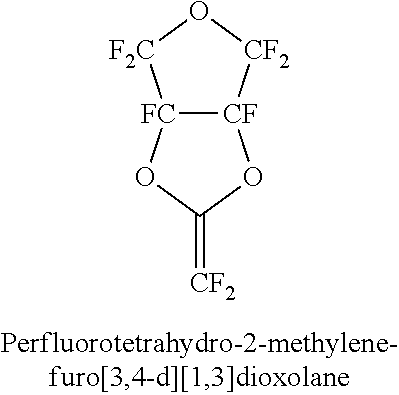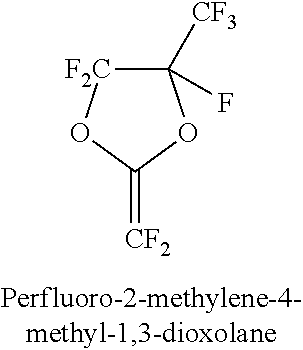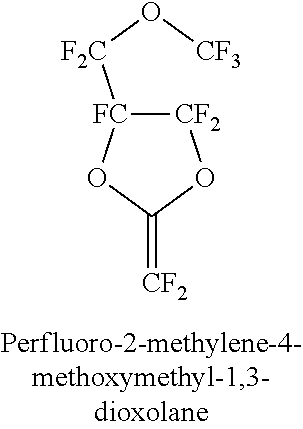Gas separation membranes based on fluorinated and perfluorinated polymers
a gas separation membrane and polymer technology, applied in gaseous fuels, hydrogen/synthetic gas production, inorganic chemistry, etc., can solve the problem that membranes previously developed for gas separation processes lack adequate selectivity for certain gas separation, and achieve the effect of higher membrane selectivity
- Summary
- Abstract
- Description
- Claims
- Application Information
AI Technical Summary
Benefits of technology
Problems solved by technology
Method used
Image
Examples
example 1
Membrane Preparation
[0080]Composite membranes were prepared using copolymer solutions prepared from the Monomers A-G found in Table 1 and copolymerized using the methods described herein.
[0081]Membranes were made using different fluorovinyls and different percentages of fluorovinyl monomers from about 20-55 mol %. The experiments established that copolymers and composite membranes having selective layers incorporating the copolymers can be made from the range of materials in Table 1.
[0082]The perfluoro selective layers were coated onto support membranes, either on a small water or by hand coating, and the membranes were finished by oven drying. Samples of each finished composite membrane were then cut into 12.6 cm2 stamps.
example 2
Pure-Gas Testing of the Perfluoro Composite Membranes
[0083]A selection of the membranes from Example 1 was subjected to gas permeation tests. The membranes were tested in a permeation test-cell apparatus with pure gases at room temperature and 50 psig feed pressure. The gas fluxes of the membranes were measured, and the permeances and selectivities were calculated.
[0084]For comparative purposes, tests were also run with membranes having selective layers made from several formulations of Hyflon® AD, Cytop®, and Teflon® AF.
[0085]The results for representative copolymers having different proportions of fluorovinyl monomers are shown in Tables 2-4, below.
[0086]
TABLE 2Pure-Gas Selectivity ResultsPure-Gas Type and Percentage of SelectivitySampleFluorovinyl MonomerH2 / CH4CO2 / CH4Polymer 130 mol % CTFE20050Polymer 255 mol % CTFE9030Polymer 353 mol % PFPVE1010Polymer 453 mol %6.07.03,3,3-trifluoro-2-(trifluoromethyl)-1-propenePolymer 523 mol % VDF8030Hyflon ®2020AD60Hyflon ®4020AD40Cytop ®5030...
example 3
Reproducibility Testing
[0087]
TABLE 4Pure-Gas Permeation Results for a Copolymer of 70 mol % D / 30 mol % CTFEPermeance (gpu)SelectivityStampsH2HeCO2N2 / CH4O2 / N2H2 / CH4He / CH4CO2 / CH41360820906.05.0190440502340770806.05.0210480503260710606.0200540504300760705.016041040Homopolymer1,8002,5301,0703.0344820of DHyflon ®1,7002,6001,3002.0203020AD60Hyflon ®4501,1202703.0409020AD40Cytop ®2907901503.05013030Teflon ®10,00010,00013,0001.05.05.06.0AF2400
[0088]Samples 1-4 were tested to check for reproducibility of performance data. The results for Samples 1-4 were also compared to data from a homopolymer of Monomer D.
PUM
| Property | Measurement | Unit |
|---|---|---|
| thickness | aaaaa | aaaaa |
| Tg | aaaaa | aaaaa |
| Tg | aaaaa | aaaaa |
Abstract
Description
Claims
Application Information
 Login to View More
Login to View More - R&D
- Intellectual Property
- Life Sciences
- Materials
- Tech Scout
- Unparalleled Data Quality
- Higher Quality Content
- 60% Fewer Hallucinations
Browse by: Latest US Patents, China's latest patents, Technical Efficacy Thesaurus, Application Domain, Technology Topic, Popular Technical Reports.
© 2025 PatSnap. All rights reserved.Legal|Privacy policy|Modern Slavery Act Transparency Statement|Sitemap|About US| Contact US: help@patsnap.com



